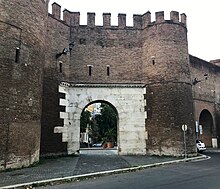Porta Pinciana
The Porta Pinciana is a late antique Roman city gate . It has been bricked up and reopened repeatedly throughout its history. In 1974 Christo and Jeanne-Claude wrapped it up in an art project.
Building history

The Porta Pinciana was built in 401 during general improvements to the Aurelian Wall under Emperor Honorius , by fortifying an already existing small sideline gate; the tower flanking on the right was given a semicircular plan instead of the original rectangular floor plan, and the identical tower on the left was added. The brick structure of the actual gate is clad in travertine and is still in good condition. The whole complex was raised to three floors at an undetermined point in time (today it was dismantled, towards the end of the 19th century many parts of the Aurelian Wall were restored to their supposedly ancient original state and freed from medieval or early modern additions), and it was made of trees and overgrown bushes.

The gate, named after the Pincio , a nearby elevation , but not one of the classic seven hills of Rome , also bore the name Porta Salaria Vetus ("old Porta Salaria "), as the Via Salaria (the "salt road") had an older route led through. At the turn of late antiquity to the early Middle Ages, the name disfigured to Porta Portitiana or Porta Porciniana . The gate, which was not the main entrance to the city, was repeatedly walled up, so that the name Turata was also created as an amalgamation of Porta murata ("walled gate"). This happened for the first time in the 9th century. Opening and closing alternate as required. The gate was closed one last time in 1808, it has been open again since 1887, and it is one of the entrances to the nearby Villa Borghese . The other gate openings that now exist to the left and right of the Porta Pinciana date from modern times and serve the increased traffic.
Belisarius and the Porta Pinciana

The Eastern Roman general Belisarius belongs to the history of the Porta Pinciana with a historical and a legendary reference.
At the end of the 5th century, the Ostrogoths - originally on behalf of East Stream, but ultimately with de facto independence - gained rule over Italy. In the wake of the dynastic battles within the Ostrogothic ruling class, the empire intervened under the energetic Emperor Justinian and triggered the Gothic Wars : The Eastern Roman general Belisarius landed in Sicily in 535 and quickly advanced to Rome, which he occupied in 536. Under his command, the Ostrogoths counterattack on the city during the siege of 537/38 was repulsed. An important episode was the battle of the Porta Pinciana, a failure of Roman troops from the city and then the unsuccessful attempt at a decisive battle in the open field, which ended with a victory for the Ostrogoths due to the imperial troops' lack of discipline. The fight is detailed in Prokopios ' Bellum Gothicum , Book V, Chapters 28-29.
The legend has been known since the Middle Ages that Belisarius was blinded on the orders of Emperor Justinian and died in complete poverty as a beggar under the Porta Pinciana in Rome. The motif of the blind Belisarius, who is only accompanied by one child, who is recognized with horror by one of his former soldiers, was repeatedly implemented in the form of images. Although the historical Belisarius was actually subjected to a high treason trial in 562 and placed under house arrest, in reality he was acquitted in 563 and died in Constantinople in 565 as a free, honored man.
Veiled by Christ
In 1974 Christo and Jeanne-Claude covered the Porta Pinciana and parts of the Aurelian Wall for forty days. The installation was as Wrapped Roman Wall , a forerunner of the concealments of Pont Neuf ten years, and Reichstag Building twenty years later.
literature
- Porta Pinciana . In: Samuel Ball Platner , Thomas Ashby : A Topographical Dictionary of Ancient Rome. Oxford University Press, London 1929, p. 412 ( online ).
Web links
Coordinates: 41 ° 54 ′ 34 ″ N , 12 ° 29 ′ 18 ″ E

